When I envisioned a visit to the Thousand Islands Winery, I imagined the grandeur of Boldt Castle, the upscale atmosphere that typifies the Saint Lawrence River experience. I expected a graying gentleman host in a shirt and tie touring me through a cellar of ancient bottles. The sign, a finely carved wooden structure with gold lettering, might lead to just that sort of place, but it doesn’t take long to realize that the Thousand Islands Winery is not as much a posh tourist destination as a working farm.
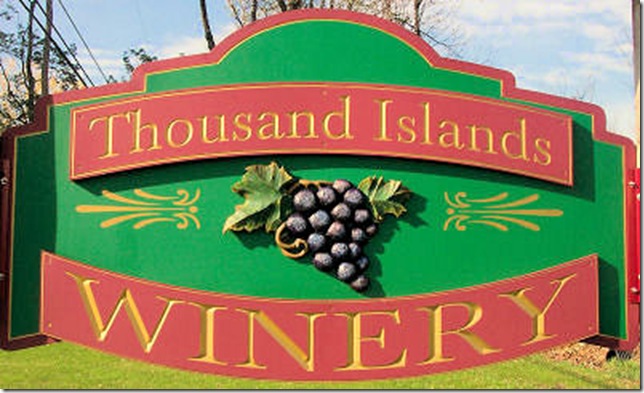 |
Photo courtesy Ashley Brenon
|
The Thousand Islands Winery welcomes tourists and local residents to celebrate wine in the Thousand Islands Region.
|
An 1836 green farm house sits close to Seaway Avenue, a vacant country road despite its suburban-like name. All around lays quiet farmland. On the not-so-distant horizon, I see the Thousand Islands’ massive, cable-stayed bridge to Wellesley Island.
The Tasting Room
The second largest of the farm buildings is a red barn labeled in white letters, “Winery.” From the muddy November chill, I step into the barn and into the tasting room. It is warm and fragrant and empty of people. A Kenny Rogers Christmas album plays softly in the background. Knotty pine walls are lined with shelves and racks of wine accessories, all in arrangements that serve both order and visual appeal. There are openers and chillers and stoppers. There are wine T-shirts and wine baseball caps. Most of all there is wine. Almost every bottle features the farm’s cream-colored label and red logo, a grapes overlaid on a silhouette of the iconic bridge. Bottles with special-edition Fort Drum labels are dedicated to the 10th Mountain Division soldiers at the military base nearby.
 At the center of the room sits a large square counter on which, the winery’s fourteen wines, several with medals around their necks, are displayed proudly. Some of the bottles have locally inspired names like North Country Red, Alexandria Bay Rose’, and Wellesley Island White. Others carry varietal names like Merlot, Pinot Grigio, and Chardonnay. At the back of the counter a crock pot steams next to a sign for hot mulled wine. I take a deep breath; this is the source of the shop’s heady perfume.
At the center of the room sits a large square counter on which, the winery’s fourteen wines, several with medals around their necks, are displayed proudly. Some of the bottles have locally inspired names like North Country Red, Alexandria Bay Rose’, and Wellesley Island White. Others carry varietal names like Merlot, Pinot Grigio, and Chardonnay. At the back of the counter a crock pot steams next to a sign for hot mulled wine. I take a deep breath; this is the source of the shop’s heady perfume. 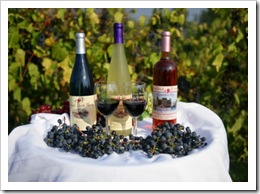
I browse lazily until a young woman comes into the shop. After a warm greeting, she introduces herself as Melissa, the Tasting Room Manager. I ask for a lesson about the place, and leading me up a heavy wooden staircase to the barn’s loft, she tells the history of the farm.
Owned by Captain Chester Massey and his wife Ida in the 1930s, the farm was a small family operation. Inspired by his tours in Europe, former American soldier Steve Conaway and his wife Erika bought the farm upon Steve’s retirement in December  2002. They hoped to operate New York State’s northern-most winery. The winery produced 1,400 gallons its first year and opened to customers on July 19, 2003; it produced 29,000 gallons in 2007.
2002. They hoped to operate New York State’s northern-most winery. The winery produced 1,400 gallons its first year and opened to customers on July 19, 2003; it produced 29,000 gallons in 2007.
The stairs spill into an enormous space with a high-beamed ceiling and wide-planked floor. Wooden chandeliers are decked with pine boughs and holly. The winery is the venue for many meetings, holiday gatherings, and weddings but, the main attraction is always the wines themselves.
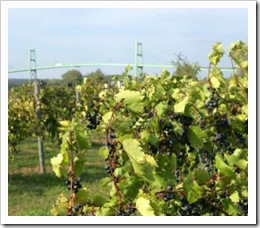 The winery grows four acres of its own grapes, but the conditions are challenging. So far north, the grapes must be cold hardy varieties in order to flourish; until the young vineyards in the area mature, much of the fruit for the wines comes in the form of juice from Long Island and the Finger Lakes. All of the grapes must come from New York State in order for the winery to maintain their distinction as a farm winery.
The winery grows four acres of its own grapes, but the conditions are challenging. So far north, the grapes must be cold hardy varieties in order to flourish; until the young vineyards in the area mature, much of the fruit for the wines comes in the form of juice from Long Island and the Finger Lakes. All of the grapes must come from New York State in order for the winery to maintain their distinction as a farm winery.
Despite the fact that growing grapes this far north is a challenge, the area is an emerging wine region and another winery is expected to open next year. This inspires cooperation, not competition, Melissa explains. More wineries will draw wine enthusiasts to the area. There are hopes of turning the already-established Seaway Trail into a wine trail.
The Lab
I meet Mike, the wine maker’s second assistant. He expresses his relief at not having to give the historical portion of the tour.
“I’ll show you how we make the wine. That’s what I do,” he says. 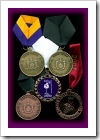
I follow him across the gravel driveway to the lab. . Inside the atmosphere is equal parts kitchen, barn, workshop and chemistry lab, the air thick with the smell of fruit and fermentation and wine. Among the shrink-wrapped pallets of finished wine and twisting hoses sit several hulking fermenting tanks. Each is made of thick translucent plastic and holds 1000 gallons. Batches ferment in about six weeks, Mike says. One stainless steel tank features a spinning whirligig on top to show how quickly the wine inside is being blended.
For a few years all of the wine was bottled, labeled and corked by hand. Now a machine fills up to four bottles at once, about 200 per hour. Even still, it will take 17 hours straight to bottle a batch. Mike speaks of filters, sulfites, sorbate and tannins. He has a one-man argument about natural versus synthetic corks. (And twist tops. Don’t even get him started about twist tops).
“There are a thousand things that can go wrong,” Mike says.
For a first-hand experience of fermentation, Mike pulls a plastic tool from a peg board.
“It’s a wine thief,” he smiles mischievously.
It looks like a turkey baster and operates in the same way. He dips it into a vat of Pinot Grigio that has just finished fermenting. He empties the baster into a glass, and holds it to the light. He smells it deeply, putting his whole nose into the glass, breathing in audibly, expertly. He tastes thoughtfully.
He passes me the glass and I mimic his behavior. I examine the color. I smell deeply. It’s earthy and bright.
“Go ahead and taste it,” he urges.
I do. The taste is complete. There is a tingle of fizz and the flavors of grape and lemon and melon.
The Cave
“This is where the wine ages,” Mike explains, gesturing to a third barn.
The windows are boarded for darkness, and the walls and ceiling are coated with spray insulation that looks vaguely rock-like. The insulation helps to keep the temperature between about 35 and 65 degrees. Thermostats were installed just last week, Mike boasts. On racks that reach nearly to the ceiling, French and American oak barrels filled with wine age for as long as two years.
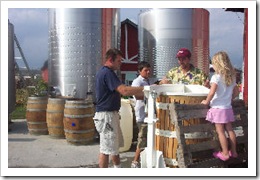 Inside the tasting room again, a few customers have arrived. They wander through racks of wine, test the weight of this opener and that souvenir champagne flute. Others ask to taste. One man announces his attention to choose cases for his relatives’ Christmas gifts.
Inside the tasting room again, a few customers have arrived. They wander through racks of wine, test the weight of this opener and that souvenir champagne flute. Others ask to taste. One man announces his attention to choose cases for his relatives’ Christmas gifts.
Melissa places a small plastic cup of velvety liquid before me. I search for the smoke and pepper said to be components of the Cabernet Sauvignon and for the American oak flavor of the Merlot. What I taste most is the simple passion that drives the creation of these wines. I taste the convergence of North Country values: the hard-working farm lifestyle and the relaxed refinement of the river.
I get into my car with two slender brown paper bags, a bottle of wine in each – the Saint Lawrence Red and the finished Pinot Grigio. I look forward to my next visit when the weather is warm.
By Ashley Brenon
Photo credits: Photographs courtesy of the Thousand Islands Winery
Assistant editor: Jessy Kahn
Ashley Brenon is a Vermont-based freelance writer who was raised in Jefferson County. She has written on food, restaurants, gardening, science, health, technology and higher education for Berkshire Living magazine, Next Step magazine and several newspapers.